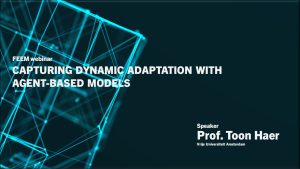Capturing dynamic adaptation with agent-based models
06.02.2023
06.02.2023
14:30 - 15:30
Professor Toon Haer (Assistant Professor, Water and Climate Risk Department, Institute for Environmental Studies – IVM)
Abstract
Decisions of individuals, farmers, businesses, insurers, and governments are a key driving factor in the evolution of natural hazard risk. Despite being a critical driver, dynamic decision-making by heterogenous agents is often not taken into account in risk assessments, and risk assessments therefore often remain limited to static assumptions on exposure and vulnerability. Over the past years, agent-based models have emerged in risk literature as a promising tool to capture dynamic (mal-)adaptive behaviour for floods (Haer et al., 2016, 2019) and droughts (Wens et al., 2020, Streefkerk et al., 2023). Agent-based models explicitly model the actions and interactions of heterogenous agents with different beliefs, risk perceptions, and decision-behaviour, and how they respond to a changing risk environment. By capturing these decision-making processes, ABMs can increase our understanding of risk, provide insights in adaptation processes, and allow us to quantify risk reduction and remaining risk in more detail. In the seminar, applications of ABM in flood and drought research will be discussed. Furthermore, the seminar will explore how different behavioural theories can be used in the ABM (Schrieks et al., 2021), and what the advantage and disadvantage of the different behavioural theories is in the context of risk assessment. Finally, the importance of combining ABM with empirical research will be discussed.
Prof. Toon Haer
Professor Toon Haer is employed as an assistant professor at the Institute for Environmental Studies (IVM), Water and Climate Risk department. The focus of his research is dynamic adaptation and risk dynamics. His research interests include (flood, wind) risk analyses, adaptation strategies, economics of adaptation and cost-benefit analyses, climate change, and integrating natural and behavioural processes in risk models across different scales.

